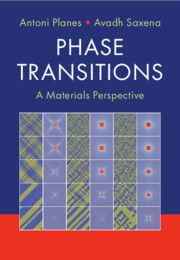Refine search
Actions for selected content:
106102 results in Materials Science
10 - Quantum phase transitions
- from Part II - Applications
-
- Book:
- Phase Transitions
- Published online:
- 01 May 2025
- Print publication:
- 15 May 2025, pp 332-352
-
- Chapter
- Export citation
5 - Caloric and multicaloric materials
- from Part II - Applications
-
- Book:
- Phase Transitions
- Published online:
- 01 May 2025
- Print publication:
- 15 May 2025, pp 175-199
-
- Chapter
- Export citation
6 - Liquid crystals and topological defects
- from Part II - Applications
-
- Book:
- Phase Transitions
- Published online:
- 01 May 2025
- Print publication:
- 15 May 2025, pp 200-237
-
- Chapter
- Export citation
3 - Ferroic materials
- from Part II - Applications
-
- Book:
- Phase Transitions
- Published online:
- 01 May 2025
- Print publication:
- 15 May 2025, pp 103-150
-
- Chapter
- Export citation
Crystal structure of trametinib dimethyl sulfoxide, C26H23FIN5O4(C2H6OS)
-
- Journal:
- Powder Diffraction / Volume 40 / Issue 2 / June 2025
- Published online by Cambridge University Press:
- 02 May 2025, pp. 162-167
-
- Article
-
- You have access
- Open access
- HTML
- Export citation
Crystal structure of niraparib tosylate monohydrate Form I, (C19H21N4O)(C7H7O3S)(H2O)
-
- Journal:
- Powder Diffraction / Volume 40 / Issue 3 / September 2025
- Published online by Cambridge University Press:
- 02 May 2025, pp. 215-223
-
- Article
-
- You have access
- Open access
- HTML
- Export citation
Crystal structure of aprocitentan Form A, C16H14Br2N6O4S
-
- Journal:
- Powder Diffraction / Volume 40 / Issue 2 / June 2025
- Published online by Cambridge University Press:
- 02 May 2025, pp. 168-174
-
- Article
-
- You have access
- Open access
- HTML
- Export citation

Phase Transitions
- A Materials Perspective
-
- Published online:
- 01 May 2025
- Print publication:
- 15 May 2025
The secrets of the sand – Mineralogy of coastal sands and dunes in Marshfield, MA, USA and comparisons to other beach sands
-
- Journal:
- Powder Diffraction / Volume 40 / Issue 2 / June 2025
- Published online by Cambridge University Press:
- 23 April 2025, pp. 114-127
-
- Article
-
- You have access
- Open access
- HTML
- Export citation
PDJ volume 40 issue 1 Cover and Back matter
-
- Journal:
- Powder Diffraction / Volume 40 / Issue 1 / March 2025
- Published online by Cambridge University Press:
- 10 April 2025, pp. b1-b2
-
- Article
-
- You have access
- Export citation
PDJ volume 40 issue 1 Cover and Front matter
-
- Journal:
- Powder Diffraction / Volume 40 / Issue 1 / March 2025
- Published online by Cambridge University Press:
- 10 April 2025, pp. f1-f4
-
- Article
-
- You have access
- Export citation
Calendar of Forthcoming Meetings: (Occurring after 1 April 2025)
-
- Journal:
- Powder Diffraction / Volume 40 / Issue 1 / March 2025
- Published online by Cambridge University Press:
- 10 April 2025, pp. 102-103
-
- Article
-
- You have access
- HTML
- Export citation
The 2024 Materials Science &Technology (MS&T24) Conference & Exhibition
-
- Journal:
- Powder Diffraction / Volume 40 / Issue 1 / March 2025
- Published online by Cambridge University Press:
- 10 April 2025, pp. 99-101
-
- Article
- Export citation
Calendar of Short Courses and Workshops: (Occurring after 1 April 2025)
-
- Journal:
- Powder Diffraction / Volume 40 / Issue 1 / March 2025
- Published online by Cambridge University Press:
- 10 April 2025, p. 104
-
- Article
-
- You have access
- HTML
- Export citation
Texture and structural refinement and quantitative Rietveld analysis of crystalline deposits to support failure investigations
-
- Journal:
- Powder Diffraction / Volume 40 / Issue 1 / March 2025
- Published online by Cambridge University Press:
- 10 April 2025, pp. 7-20
-
- Article
- Export citation
Crystal structure of sparsentan, C32H40N4O5S
-
- Journal:
- Powder Diffraction / Volume 40 / Issue 2 / June 2025
- Published online by Cambridge University Press:
- 26 March 2025, pp. 157-161
-
- Article
-
- You have access
- Open access
- HTML
- Export citation
Crystal structure of flumethasone, C22H28F2O5
-
- Journal:
- Powder Diffraction / Volume 40 / Issue 2 / June 2025
- Published online by Cambridge University Press:
- 11 March 2025, pp. 128-133
-
- Article
-
- You have access
- Open access
- HTML
- Export citation
Deconvolutional treatment about sample transparency aberration interfered by opaque and translucent sample holders in Bragg–Brentano geometry
-
- Journal:
- Powder Diffraction / Volume 40 / Issue 2 / June 2025
- Published online by Cambridge University Press:
- 10 March 2025, pp. 105-113
-
- Article
-
- You have access
- Open access
- HTML
- Export citation
Room-temperature X-ray powder diffraction data for bosentan monohydrate
-
- Journal:
- Powder Diffraction / Volume 40 / Issue 2 / June 2025
- Published online by Cambridge University Press:
- 27 February 2025, pp. 146-156
-
- Article
-
- You have access
- Open access
- HTML
- Export citation
Crystal structure of diroximel fumarate, C11H13NO6
-
- Journal:
- Powder Diffraction / Volume 40 / Issue 2 / June 2025
- Published online by Cambridge University Press:
- 27 February 2025, pp. 140-145
-
- Article
-
- You have access
- Open access
- HTML
- Export citation
